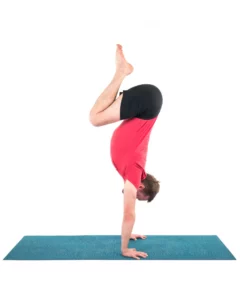Balancing Poses in Yoga: Benefits for Total Hip Replacement and Beyond

When you practice balancing poses in yoga, whether on two feet or on your head, you strengthen muscles essential for the stability of total hip replacement. Balancing challenges your ability to focus, react to fluctuations in your body, and maintain your center of gravity. It is a mental practice as much as a physical one.
Benefits of Balancing Poses in Yoga

When you practice balancing, you:
- Improve brain health
- Reduce your chance of falling
- Maintain physical coordination
- Improve your reaction time
- Strengthen key muscles that support your hip joint
Balancing helps keep the brain healthy. It improves memory, hones proprioceptive skills, and strengthens regions of the brain responsible for balance and orienting us in space. Plus, the focus required when we balance quiets the mind’s activity. This is yoga!!
Yoga Balancing Poses and Your Hips

As we lose our ability to balance, our stability diminishes, putting us at risk of falling. Hip osteoarthritis is usually accompanied by chronic pain, reduced muscle strength, and reduced ability to perform daily activities. This includes balancing, which is why a yoga practice that includes standing poses—and especially balancing poses—helps keep the key muscles responsible for our stability strong and reduces the risk of falling.
Studies show that balancing improves physical coordination and reaction time. On the yoga mat, you have a safe and controlled environment where you can practice balancing. Take advantage of this safe place to experiment and hone your balancing abilities. Finding your balance on the mat will translate to better balance in the world.
When you practice balancing, you strengthen key muscles that support your hip joint. In truth, when you balance, you strengthen muscles that provide stability throughout the body, including muscles that support the hip joint. Consider a pose like Half Moon Pose (Ardha Chandrasana). The standing leg has strong outward rotation, which strengthens the external rotators. The standing leg also has hip flexion, which strengthens hip flexors and the hamstring muscles. All these muscles play a role in supporting the hip joint.
Balancing Poses—Off the Yoga Mat
Take your balance off the mat! You can practice balance almost anywhere, like in line at the grocery store, while doing dishes at the kitchen sink, or when standing on your deck taking in the view.
Consider how standing on two feet in Mountain Pose (Tadasana) is a form of balancing. It may seem simple, but all you need to do is introduce some minor variations, and you will begin to challenge your balance:

- Try standing in Mountain Pose with your eyes closed. Focus your attention on how your weight shifts under your feet and how your body is constantly finding its center of gravity.
- Try lifting your heels to shift your weight slowly onto the balls of your feet. Can you balance on the balls of your feet for a few seconds?
- Try closing your eyes AND balancing on the balls of your feet. Notice how much we rely on our eyes for our sense of balance.
Balancing After Total Hip Replacement
As you move toward more challenging balancing poses following a total hip replacement, start small, experiment with the easier variations, and watch how your body and mind respond. And don’t be shy about using props. If you are unsure of your balance, have a countertop, chair, tree, or grocery cart nearby to hold on to.
“Balance is not something you find, it is something you create” – Jana Kingsford
Also, read...
In Celebration of Gray-Haired Yoga – Busting the Myth of the Yoga Body
Dec 12 – Charlotte Bell
Stand Firm: 6 Easy Balancing Moves for Your Daily Yoga Routine
Dec 06 – By: Olga Kabel
Related courses
Reprinted with permission from yogaforhipreplacement.com

Elizabeth Freeman (500 E-RYT, YACEP), founder of Yoga for Hip Replacement, has practiced yoga since 1985 and has been a yoga teacher since 1997. She specializes in yoga for people with movement challenges. Her students include those with a range of chronic issues, including Parkinson’s disease, multiple sclerosis, arthritis, and irritable bowel syndrome, as well as those recovering from hip, knee, and shoulder surgeries.
Motivated by her own experience with two hip replacements, she founded Yoga for Hip Replacement as a resource for people preparing for and recovering from hip surgery. She aims to offer safe and accessible yoga practices that support the best hip outcome.
Studies:
- “Good Balance = Better Brain”
- “Muscle strength, pain and disability in patients with osteoarthritis”
- “Balance and gait in total hip replacement: a pilot study”
- “Improvements in balance after total hip replacement”
- “Balance, reaction time, and muscle strength in exercising and nonexercising older women: a pilot study”
Recent articles
In Celebration of Gray-Haired Yoga – Busting the Myth of the Yoga Body
Dec 12 – Charlotte Bell
4 Yoga Poses to Help Ease High Blood Pressure
Dec 08 – Stanley Clark
Categories
Upcoming courses
Reconnecting with Strength: Your Path to Building Greater Inner Resilience
With Arielle Schwartz
Recent articles
Almost there...
Sorry, we couldn't find anything...
Yoga Practice Tips
In Celebration of Gray-Haired Yoga – Busting the Myth of the Yoga Body
I found my first grey hair when I was 22. It wasn’t completely shocking.…
Dec 12 – Charlotte Bell
Yoga Practice Tips
Judith Hanson Lasater on The Art of Teaching Yoga: Making Every Movement an Asana
Judith Hanson Lasater is one of the longest-teaching yoga teachers in the U.S. In…
Dec 09 – By:
Blood Pressure
4 Yoga Poses to Help Ease High Blood Pressure
Approximately 46 percent of Americans have high blood pressure, based on the American Heart…
Dec 08 – Stanley Clark




